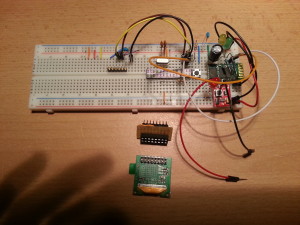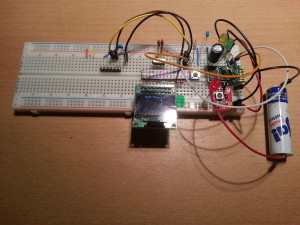I like developing Arduino projects without the usual hardware, by simply using the bare minimum that’s necessary. It’s really cheap, it can have very small dimensions and be embedded almost anywhere. You are flexible with power supplies and logic levels as well. Here is one example: simply put a Atmega 328 with UNO bootloader on a breadboard, power it up with 3.3V and you can connect efficient and cheap 3.3V components to it such as bluetooth modules and OLED displays. As you can see, the power source is a Sparkfun 3.3V step-up board, so that the whole setup can run from a single AA cell. A standard 6-pin header for the usual FTDI breakout boards is also built in.
Bluetooth connectivity is given by connecting a HC-05 master/slave BT-module. This thing can also be easily breadboarded if you solder wires only to the necessary terminals. For pinout and AT command set (for adjusting the baud rate etc.) click. There are several modules out there that look alike (the HC-06 for example), but run different firmwares and therefore different AT command sets, so watch out for that.

The OLED display used here has only 0.96” screen diagonal, but 128×64 pixels and a very high contrast. It can display a lot of information on a small area. When using the fonts from Ladyada’s libraries (see below) you can display 8×21 characters with the small font or 4×10 characters with the big font.
When communicating over 4-pin SPI you only need 7 pins in total, unlike the 20-pin KS0108 GLCD. Some SMT jumper settings have to be made for the device to operate in 4-wire SPI mode, which can be accomplished with average soldering skills. It’s pretty much self-explanatory and depicted on the PCB if you use the same device as I did. If you build the proper adapter, the display can be plugged directly next to the atmega 328 on a breadboard without using a single jumper wire (i used the pinout from the library!) for very quick and efficient prototyping.
Adafruits OLED and GFX libraries provide a great code base for the built-in SD1306 controller. Their boards have only the relevant pins broken out and the SPI-mode pre-selected for those who don’t like soldering.


Hi,
Bizarre question for you. My daughters cloud pet is broken. I need a replacement Bluetooth
Receiver and mini speaker to replace the broken one even if I have to hang this around the teddys neck. Any idea where I can get hold of such a gizmo?
Thanks!
Hi Bryan,
do you need bluetooth audio? Bluetooth has plenty of different protocols and stuff you can use it for. Got to know exactly what the original module did